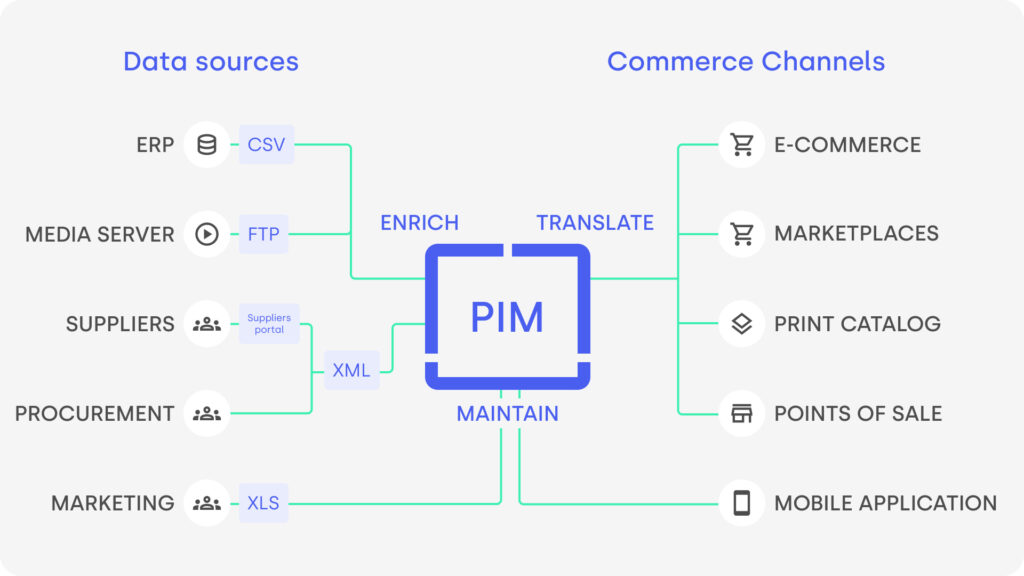Are you drowning in spreadsheets, struggling to keep your product data updated across multiple channels, or pulling your hair out trying to synchronize your online and offline inventories? Well, you’re not alone, and the good news is, there’s a solution that’s designed to put all these headaches to rest.
Enter the world of Product Information Management (PIM) systems—a game-changer in the realm of e-commerce and multichannel retailing. 🌐

This comprehensive guide will walk you through everything you need to know about PIM systems, from streamlining your product data to boosting your sales like never before. Trust us; you’ll wonder how you ever managed without it! 🚀
Ready to master the art of product information management and make “spreadsheet nightmares” a thing of the past? Keep reading to unlock the transformative power of PIM systems in your business!
Why You Need to Adopt a PIM System Now?
In today’s digital age, businesses must maintain vast amounts of product information to stay ahead. This is where a PIM system or Product Information Management System can be a game-changer. If you’re struggling with product data inconsistencies, inefficient workflows, or want to expand your ecommerce reach, read on.
What Exactly is a PIM System?
A PIM System is a centralized hub where you can collect, manage, and distribute product data. It streamlines catalogue management and ensures your product data is consistently formatted and easily accessible.
- Data Centralization: All product data are stored in one place.
- Data Enrichment: Add descriptions, images, and more.
- Data Distribution: Easily share data across multiple platforms.
Key Insight: A PIM is not just a storage solution; it’s an operational powerhouse.
Check here wikipedia’s definition.
How a PIM System Transforms Your Business 📈

Eliminate Data Silos
Before PIM, you likely had product data spread across multiple systems. A PIM system centralizes this data, eliminating the need for manual data tracking.
Enhance Customer Experience
With more accurate and rich product data, your customers can make more informed decisions. This leads to higher customer satisfaction and loyalty.
Accelerate Time-to-Market
Speed is key in ecommerce. A PIM system lets you quickly update product info and sync it across various channels, thereby accelerating your time-to-market.
Comparing Top PIM Software Solutions: A Quick Guide
Most of the PIM solutions in this table are stand-alone solutions while Stockagile’s Product Information System is a part of a more complete Retail Operating System with it’s own Point of Sale, Warehouse Management System, Order Management System and Retail insights modules.
| Features | Plytix | Stockagile | Saleslayer | Salsify | Akeneo | Pimcore |
| User Interface | ★★★★ | ★★★★★ | ★★★★ | ★★★★ | ★★★★ | ★★★ |
| Customization | ★★★ | ★★★★★ | ★★★★★ | ★★★★ | ★★★★★ | ★★★★★ |
| Price | $$ | $$ | $$$ | $$$$ | $$$ | $$$ |
| Scalability | High | High | Medium | Medium | Medium | High |
| Multichannel Support | Yes | Yes | Yes | Yes | Yes | Yes |
| API Integration | Good | Excellent | Excellent | Good | Excellent | Excellent |
| POS Integration | No | Yes | Yes | No | Yes | Yes |
| WMS Integration | No | Yes | Yes | Yes | Yes | Yes |
| Ecommerce Integration | Yes | Yes | Yes | Yes | Yes | Yes |
Real-World Examples of PIM in Action 🌐

- E-commerce Giants: Amazon and eBay use advanced PIM systems to manage millions of products. Tools like Stockagile let you sync with your favourite marketplaces to sync product information like stock levels so you don’t suffer stock outages.
- Retail Chains: Stores like Walmart utilize PIM for seamless catalogue management and inventory tracking. Centralizing your catalogue is vital when you have multiple point of sales (physical and digital).
- Manufacturers: They use PIM for streamlining data and simplifying collaboration with retailers. Sharing information with your B2B clients is key to boost your perfomance as a manufacturer or wholesaler.
The Future of PIM Systems: AI and Automation 🤖

As machine learning and AI continue to evolve, PIM systems are expected to incorporate these technologies for even better product data management.
One nice example is using AI to create atractive product descriptions for your different channels. It allows you to create copies in bulk for your whole catalogue in seconds.
Are You Ready for the PIM Revolution? 🎯
Adopting a PIM system could be the key to unlocking new markets and achieving scalable growth. By centralizing your product data management system, you improve efficiency, customer satisfaction, and ultimately, your bottom line.
Frequently Asked Questions – (FAQ) About PIM 🤔
A Content Management System (CMS) is designed to manage your website content, whereas a PIM system is designed to manage all your product data. A PIM can integrate with a CMS to ensure consistent product data across various channels.
Why is a PIM important for e-commerce businesses?
For e-commerce, PIM ensures that customers receive the most current and accurate product information. This is crucial for decision-making and can significantly improve the customer experience, thus leading to increased sales.
By centralizing product information, a PIM system ensures that all descriptions, titles, and other content are consistent and optimized for search engines. This can improve your rankings and drive more organic traffic to your online store.
While almost any business that deals with product data can benefit, e-commerce enterprises, retail chains, and manufacturers often find the most value in a PIM system due to the complexities of managing large product ranges across multiple channels.
Yes, most PIM systems are designed to integrate with eCommerce platforms, ERP systems, and other marketing technology to provide a seamless flow of product information.
The cost can vary based on the features you require and the number of SKUs you have. However, many businesses find that the efficiencies gained from using a PIM system quickly offset the initial investment.
A PIM system can greatly enhance supply chain efficiency by centralizing all product information, thereby making it easier to share data across the supply chain. This helps in reducing errors and speeding up time-to-market.





